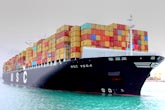 |
PLANS by ocean carriers to get rid of surplus 8,000 TEU vessels by dumping them into the Asia-East Coast South America (ECSA) tradelanes appears to have seriously backfired, and painted them into a corner, said Drewry Maritime Research.
The recent launching of MSC's new Ipanema service in the middle of April, and the subsequent announcement of the deployment of much bigger 8,000 TEU vessels by others, will result in a massive 33 per cent increase in capacity between April and July.
Even before all of the plans have been implemented, they have triggered a rate war, with spot prices from Shanghai to Santos collapsing by 26 per cent between April and May, down to US$2,810 per FEU (including THCs at both ends), according to Drewry's Container Freight Rate Insight.
Anecdotal evidence indicates that since the middle of April, the decline was even higher, and rates were still dropping in the first week of June, indicating that no one wants to be muscled out of market share peacefully.
Additional capacity comes from MSC's new Ipanema service, in addition to the current upgrading of vessels deployed in Evergreen/Cosco/Zim's ESA schedule (from an average of 6,212 TEU to 8,500 TEU), and the rationalisation of the three services offered by Maersk Line, CMA CGM, Hamburg Sud, CSAV, CSCL and Hanjin. From July, the three services will deploy 33 vessels averaging 8,000 TEU instead of 35 vessels averaging 6,295 TEU.
Although MSC appears to be at a distinct disadvantage to most other carriers in terms of economy of scale, the small vessels used in its service have been chartered at a very attractive rate of around $6,000 per day, so the sub-economic state of the charter market is being used to its disadvantage. Its new service could also be a forerunner of a much bigger affair deploying 8,800 TEU wide-beam vessels already on order.
Cargo growth cannot be the main driver behind the changes in services. Although there was year-on-year growth of 4.7 per cent from Asia to ECSA in 1Q 2013, up to 343,000 TEU, and 12 per cent on the backhaul leg to Asia, up to 132,600 TEU, the increase was spread over 12 months, whereas the planned 33 per cent growth in vessel capacity will be accomplished within just three months.
The additional vessel capacity planned for July between Asia and the East Coast of South America will result in further freight rate erosion. As much as ocean carriers would like to hide surplus 8,000 TEU vessels in the north-south tradelanes, this cannot be achieved in the current poor economic climate without creating overcapacity and rate reductions.
Asian Shipper News
|













